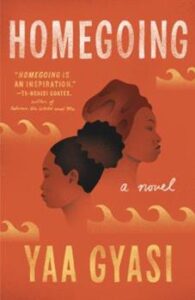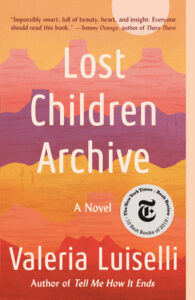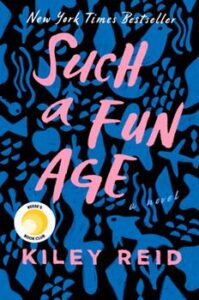This post was written by Sarah L. Hoiland, Associate Professor of Sociology, Hostos Community College, María Julia Rossi, Associate Professor of Modern Languages and Literature, John Jay College, and Ria Banerjee, Associate Professor of English, Guttman Community College
Introduction
In late May 2021, our Women Rewrite America series ended and we wanted to provide a way for our participants to contribute to the Transforming Learning in the Humanities (TLH) Blog. What did our fellow readers get out of reading three novels in the last three months of an exhausting academic year? One would have to be crazy to volunteer to write a reflection in the summer, but several of our participants enthusiastically did just that and submitted their reflections.
Gita Pai points out the importance of “hearing voices” as a form of authorial activism common to authors Yaa Gyasi, Valeria Luiselli, and Kiley Reid, and one that is critical to a peoples’ history. For Anne Connor, the experience was personal, and provided space to “read emotionally,” something not often afforded to academics. Astrid Lorena Ochoa Campo pointed out the fun and refreshing aspects of reading and discussing at the end of her first year in a tenure-track position. Doctoral candidate Sonia Adams submitted pedagogical materials including one activity that examines Homegoing within the context of the global #BlackLivesMatters Timeline on her campus.



Perhaps most critically for us in these screen-filled times, we kept reading. As a new year began, Sarah found herself reading Gayl Jones for the first time after coming across an article by Imani Perry in The New York Times and picked up Corregidora (1975) from the local library. Jones depicts female sexuality, Black feminism, queerness, and artistry in the 1930s-1940s Kentucky through protagonist Ursa Corregidora with an overlay of the generational trauma imposed by her mother and grandmother’s command to “make generations,” something Ursa is unable to do. Julia, prompted by Megan Behrent’s suggestion and her own interest in motherhood in fiction, tackled The School for Good Mothers (2021). Written by Asian American author Jessamine Chan, this novel imagines a dystopic version of motherhood in a growingly controlled world, somehow reshaping the way we think about mothers. Ria had been allergic to reading “a pandemic novel,” but encouraged by the group, she picked up Ling Ma’s Severance (2018) and found it resonating with so many of the themes touched upon by Women Rewrite America. Jane Hu’s discussion is particularly resonant for those who are following our work on this series from afar.
The three of us and our larger planning committee continue to share book titles, discuss recent books, and read books in common outside our typical selections. We think this is the kind of Transformative Learning in the Humanities (TLH) envisioned with the larger grant-funded project. For us, a group of predominantly female academics from all over the United States, reading and rereading America occurs in concert with others.
Hearing Voices
Gita V. Pai, Associate Professor of History, University of Wisconsin-La Crosse
Historian/activist Howard Zinn wants “voices of struggle, mostly absent in our history books, to be given the place they deserve.” To omit these stories, he submits in his 2004 Voices of a People’s History of the United States, would reinforce the idea that power resides in those who wield weapons, possess wealth, and so on (28). Similarly, Yaw in Yaa Gyasi’s 2016 Homegoing tells his students that history is biased, masking injustices that groups in power sustain. Amidst the 1950s Ghanian independence movement from British rule, he instructs: “So when you study history, you must always ask yourself, whose story am I missing? Whose voice was suppressed so that this voice could come forth? Once you have figured that out, you must find that story, too” (226-27).[1]
But what happens when voices that must be heard are undetectable? Through an unnamed woman in her 2019 Lost Children Archive, Valeria Luiselli confronts the complexity of unaccompanied children crossing the southern U.S. border who have disappeared and whose voices are no longer audible: “Perhaps like my husband, I’m also chasing ghosts and echoes. Except mine are not in history books, and not in cemeteries” (146). Her children’s backseat car games and playacting, she later realizes, could help tell the story of migrant children who went missing on their treks northward: “Perhaps their voices were the only way to record the soundmarks, traces and echoes that lost children left behind” (180).
And what happens when voices that must be heard are overlooked? Alix, a feminist privileged white blogger in Kiley Reid’s 2019 Such a Fun Age, neglects her toddler daughter, whose incessant chatter unnerves her: “Funneled by two massive front teeth, Briar’s voice consumed everything in its path. It was loud and hoarse and never stopped…Briar was constantly asking, singing, rambling, humming, explaining…she could always hear her daughter’s voice from the elevator, even before she reached the proper floor” (24-25). After a grocery store’s bigoted security guard accosts her twenty-something working-class black babysitter, Alix embarks on a fanatical, guilt-racked mission “to get to know Emira,” a white savior venture that brings disaster.
“Hearing voices” ordinarily implies hearing a voice when no one is present or others cannot hear. For these three women of color novelists, I suggest, it is a form of activism that gives public expression to those sometimes excluded from history books—nonwhites, children, women, workers—to awaken greater consciousness of racism and exploitation that propels social change. Today, hearing voices becomes especially crucial as U.S. legislation against teaching critical race theory in public schools, colleges, and universities gains widespread currency.
Anne Connor, Professor and Program Chair, World Languages, Southern Oregon University
When I got the invitation to participate in the Women Rewrite America Reading and Discussion Series, my marriage of 25 years had just ended. I said YES, please, sign me up. Get me out of my own thoughts. Let me read some really good books in English (I teach Spanish). And not have to design questions for my students about them. Get me out of this pandemic isolation. Let me talk to women from different disciplines. Let me learn from the way they read without having to worry about publishing an article. Distract me from all these godawful waves of disappointment, frustration, heartbreak, anger, and self-pity.
The first book, Yaa Gyasi’s Homegoing (2016), drew me right in and simultaneously right out of my own little world: I found myself floating between Africa and the U.S., traversing a complex timeline filled with stories of hardship, injustice, and families torn apart. I was fascinated by the holes in the history. Since each chapter took on the story of one descendent of the family … so many questions about the missing characters were left unanswered. This seemed quite apropos to our discussion series. Rewriting America implies the need to find those lost stories of our country and our continent — the enslaved person’s version, the women’s version, the immigrant’s version, and so on. But just in this one novel it became clear that so many stories obligatorily get left out. Everything is partial, and even when we try to understand different versions, we are left with chasms. I would never understand my ex-husband’s version of “us”. And I worry: what will our children’s version be?
In our first discussions on Zoom, I was struck by the friendliness of our group and our sincere charge of just sharing without a specific agenda, allowing for personal reactions in a nonjudgmental environment. I thought about how different that is to the way we are taught to analyze texts and the way I teach my own students to read and develop a critical eye. I also appreciated the humor in this more relaxed environment. One of my favorite comments from our discussion of the last novel, Kiley Reid’s Such a Fun Age (2019), went something like: “What the fuck is up with America’s obsession with high school? Get over it already!” This made me laugh so hard. It encapsulated a problem with so many movies and TV shows in the U.S., and again highlighted the need to not only Rewrite America but to move on from the tired scripts of our visual culture: we need to recreate and refilm America, too.
As a response to the group’s looser and more personal type of discussion, in reading the second novel, Valeria Luiselli’s Lost Children Archive (2019), I decided to let go a bit more and allow myself to read from an emotional point of view. By then I recognized I was deep in the stages of grief. Put in another way, I did not really have any other choice than to read emotionally. This ended up being rather antithetical to the style of the first-person narrator, a sound archivist, who referred to her children as “the boy” and “the girl” and methodically listed the contexts of the boxes they took with them on their trip across the country. She seemed distant, driven and deeply intellectual. Emotionally, however, she was in denial about the future of her relationship with her husband who was willing to uproot them all just to work on his own project. She was holding onto a hope that their lives could continue on together by joining him on the trip. Her goal was to conduct separate research about the lost children of Central American immigrants who were being detained and separated from their parents at the border. My initial emotional response was: Just leave that asshole! Clearly their relationship was not going to work out. Why had it taken me so long to see it in my own relationship, but in this novel, it was crystal clear to me from the very first section?
My second emotional reaction was a profound feeling of nostalgia and concern for “the boy” and “the girl”. Just 10 and 6 years old, they were imaginative and open to all of their parents’ obsessions. They clearly did not understand where they were going on this road trip or what was likely going to happen in their family’s future, but they dutifully went along with everything their parents threw at them. For example, they listened to a rather boring song selection (I know, because I downloaded the songs in order to immerse myself in the text’s soundtrack) and offered up their humorous but sincere interpretations of the lyrics. They developed their own idiosyncratic games and languages and learned to “interpret” each other for their parents’ benefit. Luiselli’s ability to capture the children’s innocent creativity was powerfully real for me as a mother. I too have a boy and a girl, but now they are young teenagers. Like the children in the novel, they used to be open and excited to “hang out” and try whatever activity I suggested. Now, as part of their natural development, they actively push me away. Reading the novel, I yearned for their younger selves. I saw my grief in a new light: it was not just about the future loss of a life I thought I would be living, but also the loss of a past which felt irretrievable. Was I crying for the boy’s loss of innocence in his narrative near the end of the novel or for my own?
Clearly, this type of non-academic reading was a gift for me at this difficult, yet open and tender juncture in my life. Though I may have initially joined the group as a means of escape, I was reminded that books and conversations about them with friends are like safe harbors in life’s uncertain waters.
Astrid Lorena Ochoa Campo, Assistant Professor, Global Cultures & Languages, UW-La Crosse
When I moved from Charlottesville, Virginia to La Crosse, Wisconsin, to start my first tenure track job in July 2020, I swore I would not buy any more books because most of my boxes were filled with them, and that made packing and unpacking an unpleasant ordeal. For this reason, as it is done nowadays, to make it “official,” I posted my promise on Facebook. I received several comments of sympathy, but most people assured me I would not be able to keep my promise. They were right. I did not buy more books for a while, but I could not resist the temptation of free books. So, when a colleague forwarded me the email about the Women Rewrite America reading and discussion series, the plan of getting free books and reading for fun got my attention. As a woman of color myself, I was immediately drawn to the idea of reading novels written by women of color. Also, after writing my dissertation during the pandemic, applying for jobs, moving, and teaching remotely, I was eager to connect and talk about books in a relaxed environment. During the virtual discussions, I enjoyed hearing several points of view and reactions to the readings. While I read the novels, I highlighted passages because I liked the words in a sentence or an idea and not because I needed to cite them in a paper. It was fun to react with my emotions to the characters’ actions and to savor the excitement of wanting to know what was coming next in the stories. By reading Yaa Gyasi’s Homegoing (2016), Valeria Luiselli’s Lost Children Archive (2019), and Kiley Reid’s Such a Fun Age (2019), I was moved, intrigued, challenged, inspired, and even triggered. But, above all, I was refreshed by new literary women’ voices in English.
Sonia Adams, Ph.D. Candidate, English, St. John’s University
Thematic Unit: Black Lives Matter within a Global Context
Lesson: Making Textual Connections with the novel Homegoing by Yaa Gyasi and the #BlackLivesMatter Timeline
Learning Activity: “Navigating Textual Connections with the #BlackLivesMatter Timeline”
Background information on the Timeline: During the Spring 2018 semester, I created the #BlackLivesMatter Timeline project aimed to engage issues of race, gender, class, and violence explored in Citizen: An American Lyric by Claudia Rankine, which was selected as a National Big Reads text by the National Endowment for the Arts. The Dr. M. T. Geoffrey Yeh Art Gallery at St. John’s University created a space for the #BlackLivesMatter Timeline to be featured in conjunction with its Citizen Exhibit. The Timeline begins at the early stages of slavery in the U.S., continuing at the juncture of the #BlackLivesMatter Movement. The year 2018 is not the ending point of the Timeline but a point of ongoing activism.
Description of the activity: “Navigating the #BlackLivesMatter Timeline” is an interactive activity in which students will engage with various modes of activism used by people of African descent in challenging systematic oppression in the U.S. In preparation for this activity, the instructor will select and assign a chapter from the novel Homegoing by Yaa Gyasi for the class to focus on. The teacher can assign the class to first review the timeline in its entirety for homework prior to working on the learning activity. Next, students will select an event, publication, or figure representing one of the following an activist, media, cultural, or historical movement/ period/ moment/ event: 1) literary activism, 2) Abolitionist Movement prior to the 1900s, 3) Civil Rights Movement, 4) Black Power Movement, 5) Black Arts Movement, 6) U.S. Women’s Suffrage Movement, 7) Black Feminist Turn in 2nd Wave Feminism, 8) Grassroots Activism, 9) College Campus Protests or Black Lives Matter, and 10) Media Platforms.
Afterwards, students will write a one-page writing piece, connecting a scene from the novel with an event, publication, or figure, centered on an activist, media, cultural, or historical movement/period/moment/event. The instructor will encourage the class to engage the content from the timeline and be selective in the genre they choose to embark on for their writing piece. The writing piece can be a personal narrative, manifesto, flash-fiction, poem, or editorial. It is important for the instructor to give the class a certain level of autonomy in engaging Homegoing and the #BlackLivesMatter Timeline and choosing a genre that caters to their learning interests.
Objectives of the activity:
- Explore facets of U.S. history, based on the selected passage from the novel Homegoing and the #BlackLivesMatter Timeline.
- Select an activist, media, cultural, or historical movement/period/moment/event from the #BlackLivesMatter Timeline of interest that connects to the passage of the novel.
- Pursue a genre of writing in which to draw connections between the novel and respond to the selected activist, media, cultural, or historical movement/period/moment/event.
Method for assessing student learning: Instructors will assess student learning with the #BlackLivesMatter Timeline and Homegoing through their understanding and engagement with historical details.
Additional Resources by Sonia Adams:
- Course Design and Curriculum Unit
- Social Justice Resources List
- Documentary Poetry, Poetics, and Craft Learning Activity
[1] By including the “voices” of the enslaved, those who lived through years of sharecropping and Jim Crow, incarcerated individuals, etc., Gyasi’s historical fiction novel itself embodies Yaw’s advice.

